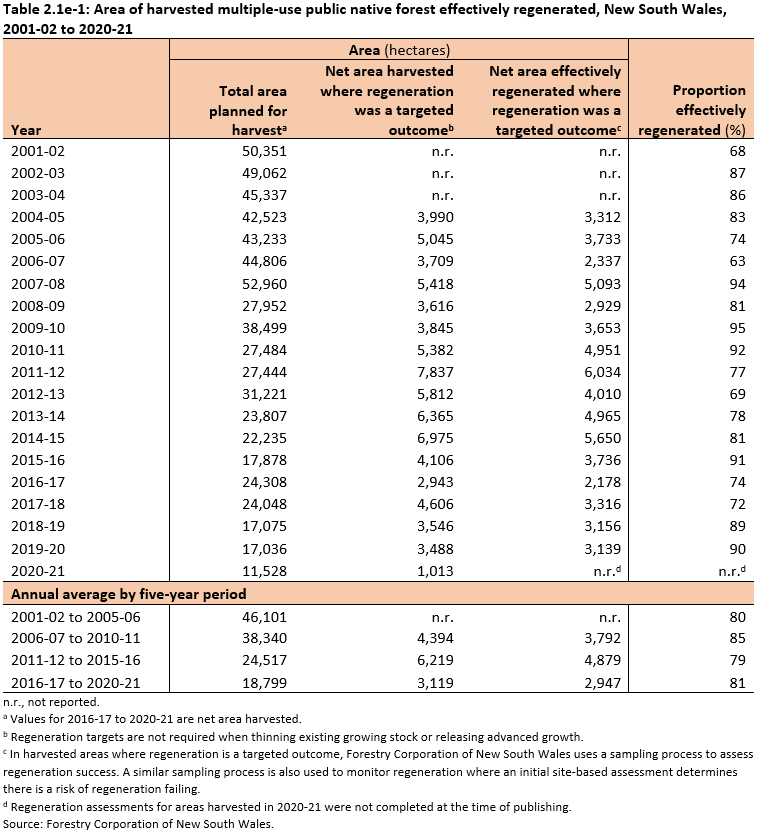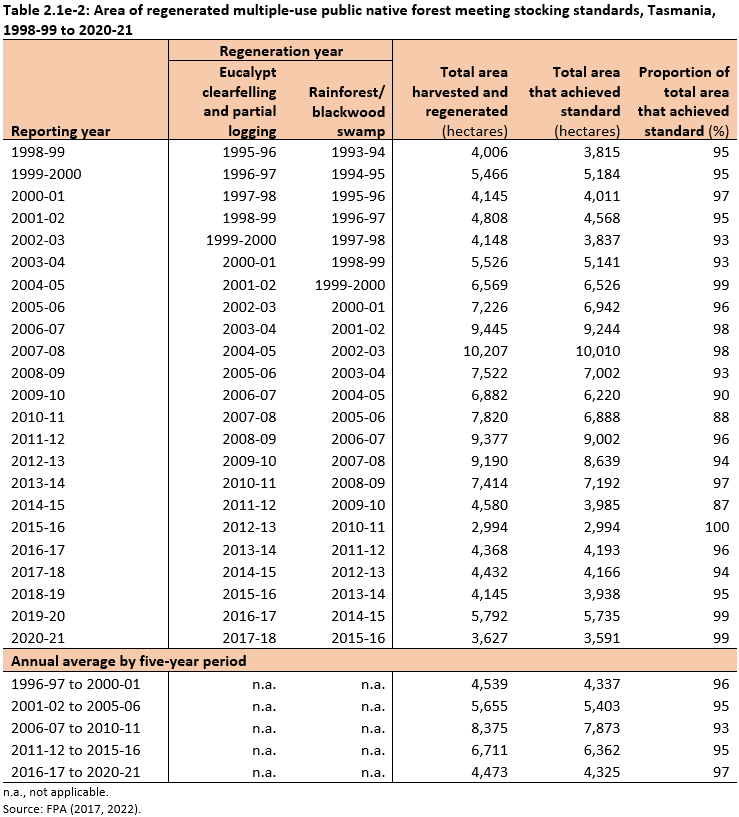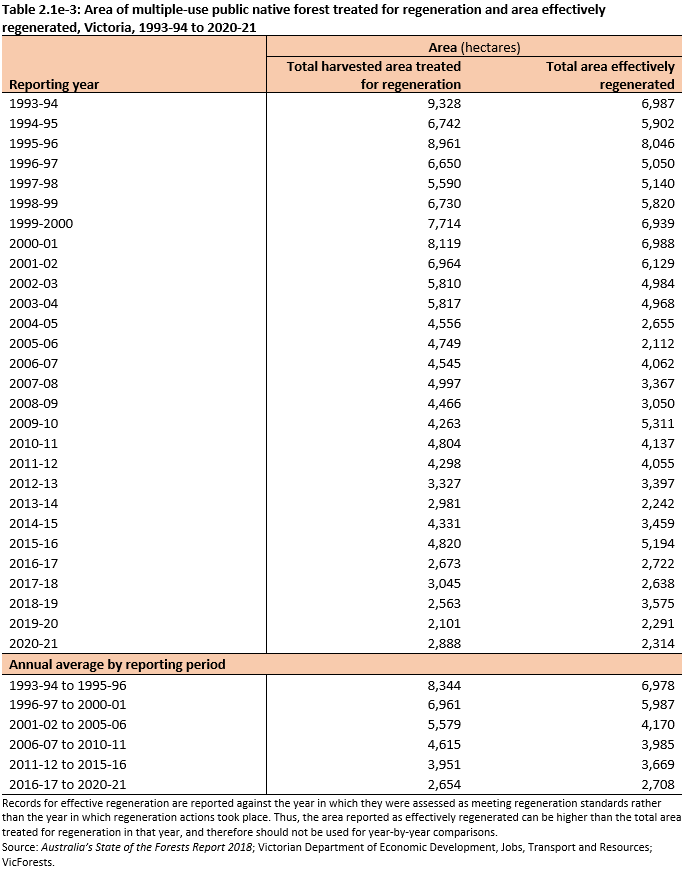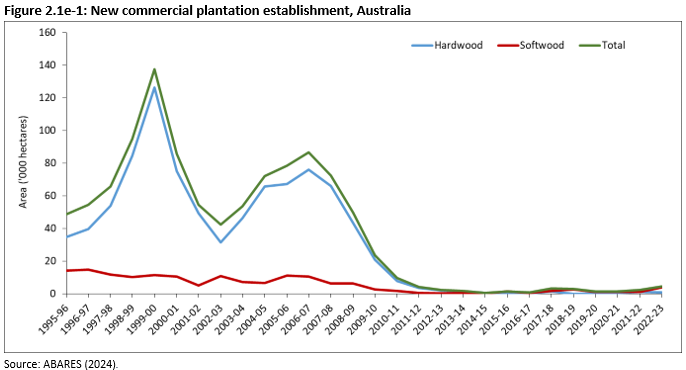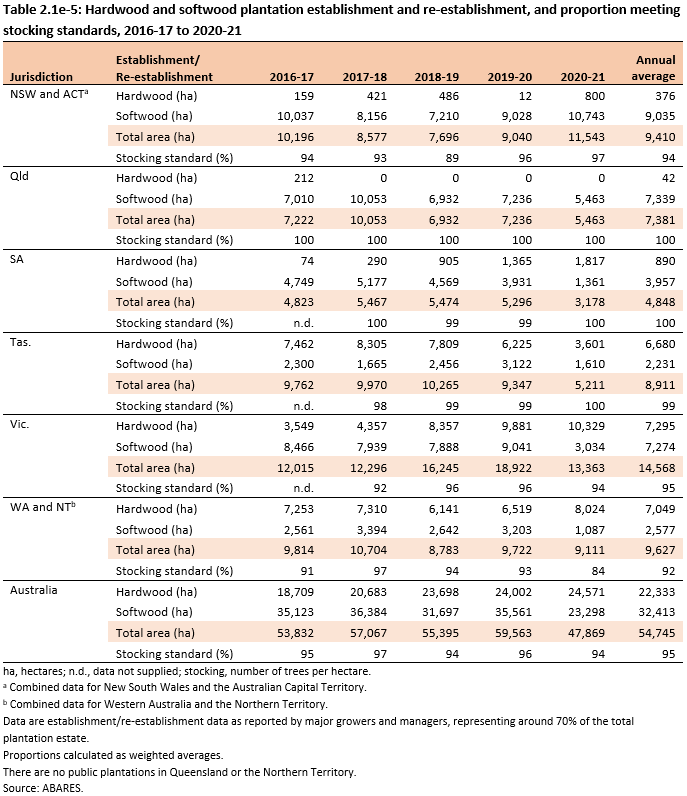This indicator is used to assess the success of the re-establishment of forests after harvesting. Re-establishment is critical to the maintenance of the productive capacity of the forest.
This is Key information for Indicator 2.1e, published October 2024.
- Over the period 2016-17 to 2020-21, the annual average proportion of harvested multiple-use public native forest effectively regenerated, as assessed against stocking standards was 81% in New South Wales, 100% in Queensland, and 97% in Tasmania. For Victoria, areas treated for regeneration were formally assessed as meeting regeneration standards. For Western Australia, the level of regeneration was assessed as adequate.
- Lower levels of regeneration success typically occur in years affected by drought, bushfire, low availability of seed, or an inability to carry out regeneration treatments. Higher levels of regeneration success typically occur when environmental conditions are more favourable.
- Establishment of new commercial plantations in Australia has declined from 86.6 thousand hectares in 2006-07 to 4.5 thousand hectares in 2022-23.
Forest regeneration in a forestry operation scenario typically refers to new trees that establish in a native forest after harvesting. Regeneration can occur naturally or through management intervention such as burning, mechanical disturbance, sowing seed, or planting seedlings. Regeneration is a targeted outcome of wood harvesting under many of the silvicultural (forest management) systems used in native forestry (see Indicator 2.1a for descriptions of silvicultural systems). Ensuring effective regeneration of native forests after wood harvesting is a fundamental requirement of sustainable forest management. Regeneration success determines the long-term productivity, growth, dynamics and composition of forest stands.
Codes of forest practices, silvicultural guidelines and other regulatory instruments require state agencies responsible for the management of multiple-use public native forests to quantitatively assess the effectiveness of regeneration after harvesting to determine if it meets required thresholds. Some states also apply codes of practice and regulations to private native forests.
The states have established standards for the effective regeneration of multiple-use public native forests. Where the specified regeneration and stocking standards (number of trees per hectare) are not achieved after harvesting in multiple-use public native forests, remedial action (such as planting seedlings) is carried out by the relevant forest management agency.
Regeneration is usually assessed one to three years after harvesting to allow time for seedlings, coppice (regrowth from tree stems) or lignotuber sprouts (regrowth from tree roots) to establish and be detected. Further follow-up treatment to promote regeneration or supplementary planting is carried out if the regeneration standards are not met at the first assessment. Sites successfully regenerated in accordance with codes of forest practices, silvicultural manuals and other regulatory instruments can subsequently be impacted by environmental conditions such as bushfires, grazing and browsing by native and non-native animals, and invasive weeds.
Regional differences in forest type, climatic and biophysical conditions, and management objectives mean that each state has its own method of assessing the success of regeneration. Assessment techniques are similar across jurisdictions for even-aged forests, but are more variable for multi-aged forests (where there is a large variation of tree age, size and height within the same forest stand).
Silviculture type, retention of seed trees, prescribed fire and mechanical site disturbance are variously employed to encourage regeneration in multiple-use public native forests. These methods are sometimes combined with the aerial sowing of seed. Some silvicultural systems require adequate on-site regeneration to be present before wood harvesting takes place (such as shelterwood and native cypress pine silvicultural systems). The promotion of a subsequent regeneration event is not a priority when a young regrowth stand is thinned or during a light selective harvesting operation targeting specific products.
Over the period 2016-17 to 2020-21, the annual average proportion of harvested multiple-use public native forest that was effectively regenerated, as assessed against stocking standards, was 81% in New South Wales, 100% in Queensland, and 97% in Tasmania (Table 2.1e-1 to 2.1e-3). For Victoria, areas treated for regeneration were formally assessed as meeting regeneration standards. For Western Australia, the level of regeneration was assessed as adequate.
New South Wales
In New South Wales, effective regeneration was on average 81% in multiple-use public native forests for the period 2001-02 to 2020 21 (Table 2.1e-1). In individual years, regeneration was generally above 70%, and in the three years where regeneration rates were below 70%, the impact of drought was a significant factor. Bushfires also affected regeneration on harvested areas in some of these forests.
A sampling process is undertaken in New South Wales to assess the effectiveness of regeneration where regeneration is a targeted outcome of the wood harvesting operation, or where a site-based assessment determines a risk of regeneration failure. A regeneration threshold of 65% of assessed plots in any given harvested area is considered adequate stocking. Additional silvicultural treatment is applied to remediate areas where the threshold is not met, however, these areas are not reported in Table 2.1e-1.
Click here for a Microsoft Excel workbook of the data for Table 2.1e-1.
Queensland
Effective regeneration was reported as being 100% for the period 2000-01 to 2020-21 in Queensland. Effective regeneration is monitored as part of the post-harvest audit process carried out by the Queensland Parks and Wildlife Service.
In Queensland, single-tree selection silvicultural systems that suit the ecology of the eucalypt and native cypress pine forests have been applied since 2000. These systems retain a mix of mature trees and regeneration of various ages. There is generally an abundance of regeneration in Queensland native forests following harvesting (QPWS 2020). In these forest types, regeneration is generally established continually and naturally from seed, coppice or lignotubers in the gaps produced during harvesting operations.
Tasmania
Between 2016-17 to 2020-21, an annual average of 97% of harvested multiple-use public native forest met the required regeneration standard (Table 2.1e-2). Since 1998-99, between 87% and 100% of multiple-use public native forest harvested and regenerated met the required regeneration standard.
In Tasmania, the Tasmanian Forest Practices Code 2015 and subsequent Tasmanian Forest Practices Code 2020 (FPA 2015; FPA 2020) require that post-harvest regeneration sowing and planting mixtures in native forests must approximate the natural composition of canopy tree species prior to wood harvesting. The required stocking standard (number of trees per hectare) is based on broad forest types and the silvicultural system under which the coupe was harvested. Where surveys show inadequate stocking rates, additional regeneration treatment is required.
Click here for a Microsoft Excel workbook of the data for Table 2.1e-2.
Victoria
The majority of areas of multiple-use public native forest formally treated for regeneration in Victoria were assessed as meeting regeneration standards over the period 2016-17 to 2020-21. Records for successful regeneration (presented in Table 2.1e-3) are not linked to the year in which harvesting took place. Rather, the area effectively regenerated is reported in the year in which it was assessed as meeting regeneration standards. This is because regeneration treatments (such as burning and seed sowing) may be delayed to subsequent years after harvesting due to unfavourable environmental conditions or resource limitations, and regeneration assessments may not occur for several years after the regeneration treatment, while the regeneration is growing to an assessable level. Thus, the area reported as meeting regeneration standards in a particular reporting year, or period, can exceed the area reported as having been treated for regeneration.
Lower levels of regeneration success occurred in years affected by drought, bushfire, low availability of seed, or an inability to carry out regeneration treatments. Higher levels of regeneration success occurred in years with favourable environmental conditions, or where regeneration from previous years had reached a standard that could be assessed as meeting the regeneration standard. A harvested coupe that does not meet the minimum regeneration standards after the initial assessment is further treated, however these areas become increasingly difficult to regenerate after the first attempt due to understorey species competition (for example, Acacia spp.) and associated vegetation management difficulties.
Prior to the disbanding of Victoria’s commercial harvesting agency, VicForests, on 30 June 2024, harvested coupes were regenerated by VicForests. When harvested coupes met regeneration thresholds, they were handed back to the land management agency, the Department of Energy, Environment and Climate Action (formerly the Department of Environment, Land, Water and Planning) for ongoing management. The restoration and regeneration of forests following both natural and human disturbance is now undertaken by Victoria’s Department of Energy, Environment and Climate Action (DEECA 2024).
Click here for a Microsoft Excel workbook of the data for Table 2.1e-3.
Western Australia
Between 2001-02 and 2010-11, Western Australia reported 100% or near 100% effective regeneration of all harvested areas (Table 2.1e-4). Results from regeneration assessments since 2010-11 are not available, however, the End-of-term review of performance of the Forest Management Plan 2014-2023 (CPC 2022) reports that adequate regeneration was achieved in sampled areas. The Forest Management Plan 2014-2023 (CCWA 2013) and previous forest management plans (CALM 1994; CCWA 2004), which cover the main wood production areas in south-west Western Australia, required that regeneration success and effective stocking rates be monitored in publicly owned native forests.
Regeneration assessment timing and establishment stocking density standards differ between karri (Eucalyptus diversicolor) and jarrah (E. marginata) due to their biological differences, with assessment and monitoring of outcomes varying between six months to three years after completion of harvesting. During the period 2014 to 2020, all karri regeneration treatments met stocking standards within 18 months of harvest, while jarrah regeneration was effective for all areas where treatment was completed within 30 months of harvest (CPC 2022).
Regeneration methods differ between karri and jarrah forest types. In karri dominated forest, areas are replanted to a minimum stocking density after harvesting and regeneration burn. In jarrah forest types, satisfactory regeneration can be achieved with a regeneration burn which releases and promotes the growth of existing lignotuberous stock (regrowth from remnant tree roots) or through seed-fall from retained overstorey trees and subsequent seedling establishment.
Although large-scale commercial wood harvesting ended in the multiple-use public native forests of south-west Western Australia from 01 January 2024, the Forest Management Plan 2024-2033 recognises that regeneration treatments in a selection of coupes harvested up until that date will need to continue until satisfactory regeneration is achieved (CPC 2023).
Click here for a Microsoft Excel workbook of the data for Table 2.1e-4.
The size of Australia’s commercial plantation estate depends on the establishment of new plantations on land not previously used for plantation forestry and the extent to which existing plantations are re-established after final harvest. The decision to re-establish plantations depends on factors such as site-suitability, previous yield, grower intent, market demand and competition with alternative land-uses.
Establishment of new commercial plantations in Australia has declined from 86.6 thousand hectares in 2006-07 to 4.5 thousand hectares in 2022-23 (Figure 2.1e-1). The average annual rate of commercial plantation establishment for the period 2016-17 to 2022-23 was 2.3 thousand hectares, which is a slight increase from the average of 2 thousand hectares per year between 2011-12 to 2015-16 (ABARES 2024). There was a modest increase in 2021-22 and 2022-23, coinciding with the release of the 2017 Plantation Forestry Method, which provided the rules for crediting carbon sequestered in plantations under the Australian Carban Credit Unit (ACCU) Scheme. Under the ACCU Scheme plantation growers can receive income for sequestering carbon during the plantation rotation in certain situations. As of 01 July 2023, there were 72 plantation projects of varying scale registered under the ACCU Scheme Forestry Method across Australia (CER 2024).
Click here for a Microsoft Excel workbook of the data for Figure 2.1e-1.
In 2020-21, 48 thousand hectares of commercial plantation forest was established or re-established in Australia (Table 2.1e-5). The average rate of establishment/re-establishment between 2016-17 and 2020-21 was 55 thousand hectares. During this time the total plantation estate area decreased by 11% (see Indicator 2.1b for area and age class of plantations).
Victoria had the largest contribution of commercial plantation establishment/re-establishment with an annual average of 15 thousand hectares (27%), followed by Western Australia and the Northern Territory together with 10 thousand hectares (18%) and New South Wales and the Australian Capital Territory together with 9 thousand hectares (17%) (Table 2.1e-5).
Total commercial softwood plantation establishment/re-establishment in Australia averaged 32 thousand hectares per year between 2016-17 and 2020-21 (Table 2.1e-5). New South Wales and the Australian Capital Territory together accounted for 9 thousand hectares (28%) of Australia’s average yearly established/re established softwood plantation area, and Queensland and Victoria each accounted for 7 thousand hectares (22% each).
Total commercial hardwood plantation establishment/re-establishment in Australia averaged 22 thousand hectares per year between 2016-17 and 2020-21 (Table 2.1e-5). Tasmania, Victoria, and Western Australia with the Northern Territory each accounted for 7 thousand hectares (94% combined) of Australia’s average yearly established/re-established hardwood plantation area. Together, New South Wales with the Australian Capital Territory, Queensland, and South Australia combined accounted for only 1 thousand hectares (6%) of the average annual hardwood plantation establishment/re-establishment in Australia.
Nationally, 95% of established and re-established plantations met the stocking standard for the period 2016-17 to 2020-21, ranging from 92% in Western Australia and the Northern Territory together to 100% in Queensland (Table 2.1e-5). Most public and private plantation growers and managers have internal management systems to assess plantation stocking rates after establishment/re-establishment. Annual stocking standards between 2005-06 and 2015-16 are available in previous reports in the Australia’s State of the Forests Report series.
Click here for a Microsoft Excel workbook of the data for Table 2.1e-5.
Tasmania is the only jurisdiction that reports trends in land-use following harvest of commercial plantation forests. During the five-year period 2016-17 to 2020-21, the average annual plantation area harvested in Tasmania was 15 thousand hectares (Table 2.1e-6). By proportion, an average of 21% of the total plantation area harvested between 2011-12 to 2020-21 was planned for a change in land use, compared to an average of 4% of the plantation area harvested between 1999-2000 to 2010-11. The elevated rate of conversion to non-plantation use commenced in 2013-14 and was driven by increasing agricultural returns, the expansion of irrigation schemes and the collapse of forestry Managed Investment Schemes (FPA 2022). Land use options comprise plantation re establishment, conversion to non-forest land use, and re-establishment of native forest. In any given year plantation owners/managers may choose to delay re-establishment operations, or convert more or less area to an alternative land use.
Click here for a Microsoft Excel workbook of the data for Table 2.1e-6.
ABARES (Australian Bureau of Agricultural and Resource Economics and Sciences) (2024). Australian plantation statistics 2022-23 update, Australian Bureau of Agricultural and Resource Economics and Sciences, Canberra. doi.org/10.25814/dkcj-xy27
CALM (Department of Conservation and Land Management) (1994). Forest Management Plan 1994–2003, Department of Conservation and Land Management, Perth.
CCWA (Conservation Commission of Western Australia) (2004). Forest Management Plan 2004–2013, Conservation Commission of Western Australia, Perth.
CCWA (Conservation Commission of Western Australia) (2012). Forest Management Plan 2004–2013 End-of-term Audit of Performance Report, Conservation Commission of Western Australia, Perth.
CCWA (Conservation Commission of Western Australia) (2013). Forest Management Plan 2014–2023, Conservation Commission of Western Australia, Perth.
CER (Clean Energy Regulator) (2024). ACCU Scheme Project Register, Clean Energy Regulator, Canberra.
CPC (Conservation and Parks Commission) (2022). End-of-term review of performance of the Forest Management Plan 2014–2023, Conservation and Parks Commission, Department of Biodiversity, Conservation and Attractions, Perth.
CPC (Conservation and Parks Commission) (2023). Forest Management Plan 2024–2033, Conservation and Parks Commission, Department of Biodiversity, Conservation and Attractions, Perth. dbca.wa.gov.au/management/forests/forest-management-plan
DEECA (Department of Energy, Environment and Climate Change) (2024). Additional Environmental Protections: Protecting valuable plants and animals, Department of Energy, Environment and Climate Change, Melbourne. Accessed June 2024.
Downham R and Gavran M (2020). Australian plantation statistics 2020 update, Australian Bureau of Agricultural and Resource Economics and Sciences, Canberra. doi.org/10.25814/5ecb5411d91fa
FPA (Forest Practices Authority) (2015). Forest Practices Code 2015, Forest Practices Authority, Hobart.
FPA (Forest Practices Authority) (2017). State of the forests Tasmania 2017, Forest Practices Authority, Hobart.
FPA (Forest Practices Authority) (2020). Forest Practices Code 2020, Forest Practices Authority, Hobart.
FPA (Forest Practices Authority) (2022). State of the forests Tasmania 2022 data report, Forest Practices Authority, Hobart.
QPWS (Queensland Parks and Wildlife Service) (2020). Code of practice for native timber production on Queensland’s State forest estate 2020, Queensland Parks and Wildlife Service, Brisbane.

